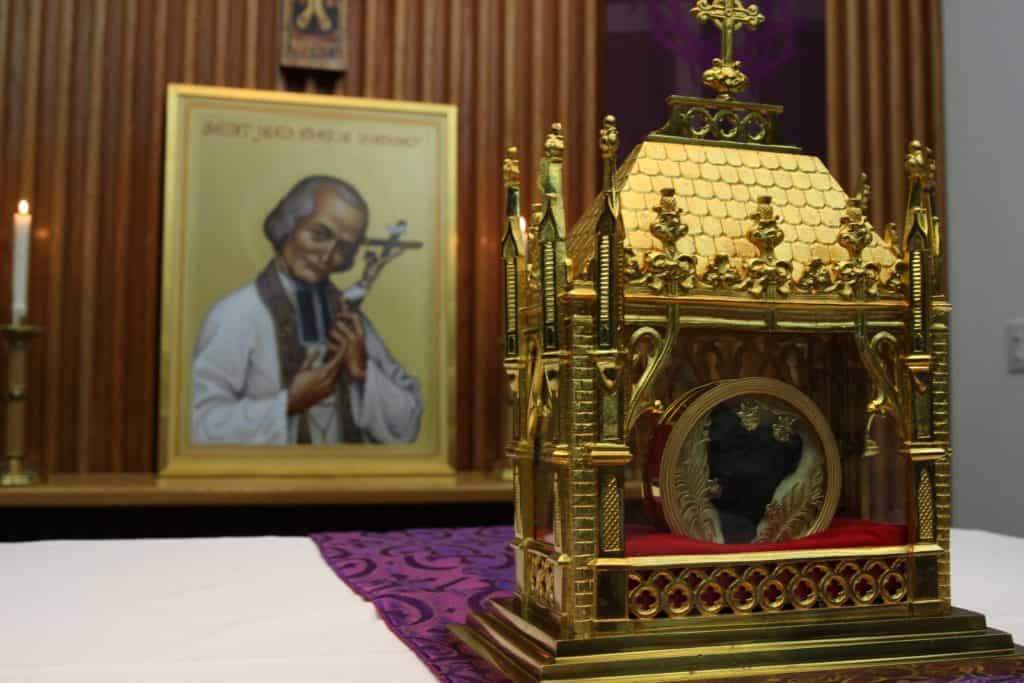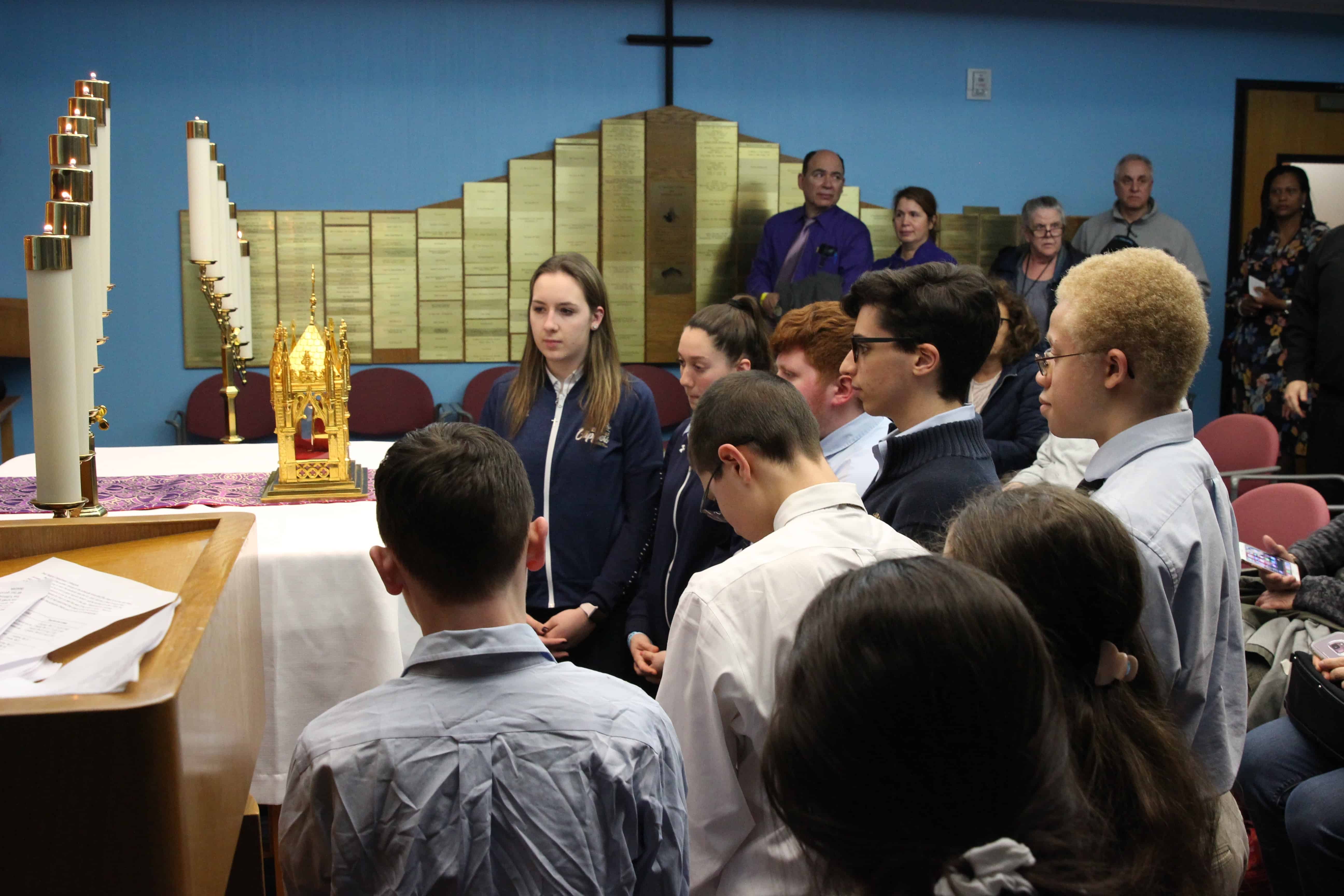Last month, Brooklynites had the opportunity to see the incorrupt heart of St. Jean Vianney – also known as the Curé of Ars – as it continues to make its way through the United States. The Shrine of Ars, France, has entrusted the major relic to the Knights of Columbus, the world’s largest Catholic fraternal organization.
It was on display for adoration for the faithful in the Brooklyn Diocese at Xaverian High School (Bay Ridge) and St. Thomas Aquinas Church (Flatlands). The public veneration was held at Xaverian on April 10, where dozens of people, including students, prayed and venerated the undecomposed heart.
Deacon Kevin McCormack, principal of Xaverian High School, said they were asked by Father Michael Gelfant, pastor at St. Finbar Catholic Church and associate state chaplain for the Knights of Columbus, if they’d be willing to host the relic.
“We were, of course, very thrilled. Most of the places [along the tour] were seminaries, cathedrals or parishes, so we were one of the few schools that were able to host,” McCormack said. “It was definitely something unique to most of the kids, [and] most people in the school hadn’t seen something like this. It was a real honor and it introduced us – and even reintroduced others – to how important St. Jean Vianney is and to some of the mysteries behind the Church.”

Jean Vianney became an ordained priest in 1815 after he and his family survived the dark years of the French Revolution. He was later assigned to the small farming community of Ars, whose parish had consisted of 260 people. The Knights of Columbus say that Jean Vianney became known for his wise spiritual counsels and the gift of reading hearts, often hearing confessions for up to eighteen hours a day as people came from across Europe to see him. He also built an orphanage for homeless children and received beggars with an open heart and hand.
Vianney died in 1859 at the age of 73 and was officially declared a saint by Pope Pius XI in 1925. He’s known as the patron saint of parish priests. According to the Knights of Columbus, the heart was removed 45 years after his death – in recognition of his burning love for God and humanity – and has since resisted decomposition. It’s been encased in a gold 17th-century French reliquary, designed much like a church building, and is normally enshrined in the Shrine of the Curé’s Heart, located in France. Today, St. Jean Vianney’s incorrupt body is also in a glass reliquary at the Basilica of Ars.
A relic, an object associated with a saint that may be offered to the faithful for veneration, is not to be worshipped and is classified into one of three categories: first, second or third class. A first-class relic is a physical part of the saint, which is what St. Jean Vianney’s heart is classified as. A second-class relic is an object routinely used or touched by a saint during life, like a piece of clothing, a book or pen. A third-class relic is an object that is reverently touched to a first-class relic.
The U.S. “Heart of a Priest” tour, which began in Nov. 2018, will conclude on May 29 in Bismarck, North Dakota, after more than 100 stops. New York was the 29th state in the nation to receive the relic. For more information about St. Jean Vianney or about the tour, visit kofc.org/vianney.
Top photo of Xaverian High School students reflecting in front of St. Jean Vianney’s incorrupt heart. Photo by DeGregorio.
Author
-

George Fiala has worked in radio, newspapers and direct marketing his whole life, except for when he was a vendor at Shea Stadium, pizza and cheesesteak maker in Lancaster, PA, and an occasional comic book dealer. He studied English and drinking in college, international relations at the New School, and in his spare time plays drums and fixes pinball machines.
View all posts
George Fiala has worked in radio, newspapers and direct marketing his whole life, except for when he was a vendor at Shea Stadium, pizza and cheesesteak maker in Lancaster, PA, and an occasional comic book dealer. He studied English and drinking in college, international relations at the New School, and in his spare time plays drums and fixes pinball machines.











4 Comments
Pingback: 1. New York and Brooklyn from Michael_Novakhov (111 sites): “Flatlands Brooklyn” – Google News: French Saint’s Incorrupt Heart Comes to Brooklyn During National Pilgrimage Tour – The Red Hook Star-Revue – Brooklyn NY
Pingback: 1. New York and Brooklyn from Michael_Novakhov (111 sites): "Flatlands Brooklyn" – Google News: French Saint's Incorrupt Heart Comes to Brooklyn During National Pilgrimage Tour – The Red Hook Star-Revue | The Brooklyn Bridge
Pingback: 1. New York and Brooklyn from Michael_Novakhov (111 sites): “Flatlands Brooklyn” – Google News: French Saint’s Incorrupt Heart Comes to Brooklyn During National Pilgrimage Tour – The Red Hook Star-Revue – New York Web N
Pingback: 1. New York and Brooklyn from Michael_Novakhov (111 sites): "Flatlands Brooklyn" – Google News: French Saint's Incorrupt Heart Comes to Brooklyn During National Pilgrimage Tour – The Red Hook Star-Revue | The Brooklyn Radio - bklynradio